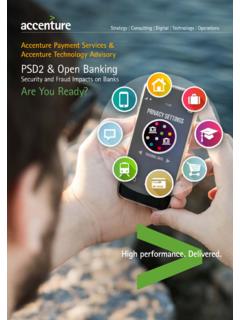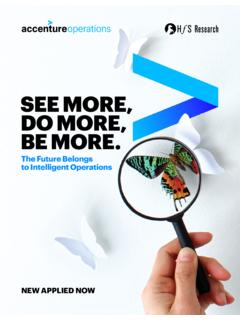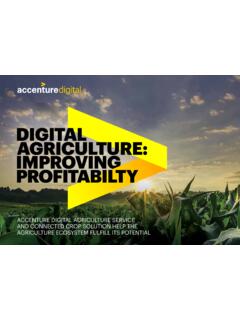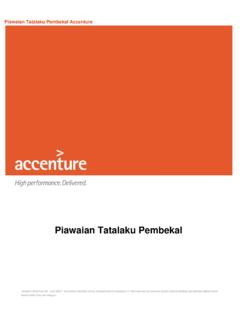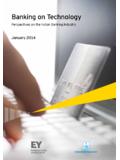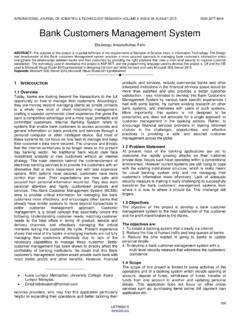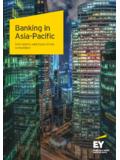Transcription of Technology for People - Accenture
1 banking Technology vision 2017 . Technology . FOR People . Banks' path to becoming their customers' everyday trusted advisor and their staff's employer of choice INTRODUCTION. There is no argument that Technology is changing banking . In traditional banks, basic transactions continue to migrate from physical to digital channels, leading to major changes in distribution mix as banks downsize their branch networks. In many developed markets, startup financial Technology (fintech) companies continue to nibble at the edges of the industry, siphoning off both volume and value in payments and lending. In Asia, the migration has been more dramatic, with ecommerce players like Ant Financial becoming the market leaders in areas like mobile payments. We are also seeing the GAFAs (Google, Amazon , Facebook . and Apple ) circling the banking industry, looking for ways to participate and create value without taking on the burden of a regulated balance sheet.
2 Finally, the focus of European regulators on creating API-driven open banking may be a harbinger of more intrusive, consumer-oriented regulation that uses Technology to reshape industry competitive dynamics. Yet, despite these forces of change, the Some banks, like RBC , BBVA and mBank, aim migration of volume and revenue outside to become Digital Relationship Managers, of the traditional banking sector remains creating and relying on customer- and limited in most markets. This creates a advice-centric, integrated ecosystems to window of opportunity for banks to respond, meet a broad range of everyday financial incorporating the latest Technology trends and non-financial needs. Others, like and repositioning their business models to Square and Quicken Loans , are deciding be more competitive and sustainable in the to compete as Digital Category Killers, digital economy. However, in a world of doing one thing very well to serve a narrow value chain fragmentation and plug-and-play set of customer needs while keeping Technology , there is likely to be far more their own value chain participation high.
3 Diversity of successful bank business models Others, like solarisBank and Fidor Bank, are in the future. positioning as Open Platform Players that offer a gateway through which other product providers (most likely Digital Category Killers) can interact with customers, create 2 banking Technology vision 2017 Technology FOR People . CONTENTS #TECHVISION2017. and sell products and services, and share their ability to move at the speed they think value. Still others, like the recently launched is necessary. They also recognize that at some CLEAR Bank, hope to thrive as Utility Providers, point, banks may start to lose ownership manufacturing and distributing banking of customer interactions as some digital products using a lean operating cost structure ecosystem platforms put others in control while leaving management of the customer and new regulation makes permission- interaction to others.
4 Of course, a mix of and granted data public. Despite this potential variations on these four business models future in which banks risk becoming irrelevant, will emerge as banks choose what best suits banks' investment efforts are not keeping their markets and customer segments. pace with the challenges. Less than half ( percent) of bankers say they are investing As banks' chart a new course and seek to comprehensively in digital as part of their reshape their business models to compete overall strategy. in a digital world, it is easy to assume that technological prowess will become the Thus, the People challenge for banks is dominant source of competitive advantage. twofold. For customers, banks need to That humans will fade from the picture as enable their natural migration towards customers interact almost exclusively with digital transactions. They also need to create digital agents.
5 However, we believe that opportunities through sales and customer tomorrow's winners will be characterized service touchpoints to route customers back not only by their technological prowess, but into a conversation with a staff member also by their ability to use that Technology whenever they need and want it. Staff to empower their staff. We believe it is that members must be fully empowered by combination of People and Technology that Technology and data to offer the best advice will truly create competitive advantage in at the right time. For employees, banks need the banking industry of the future. to use Technology to empower them to do what People do best: be empathetic, solve The paradox of digital is that while customers problems and provide the human interaction want seamless digital transaction experiences that the vast majority of customers still want on the platforms of their choice (many of from their bank.)
6 In this model, banks remove which the banks will not own), 87 percent the boring and administrative tasks from of consumers still see themselves using employees by using Technology to amplify branches in the future, and they want human what is truly differentiating about personal interaction when they go The challenge interactions and, in the process, make their is therefore to integrate digital innovations jobs more productive and more meaningful. into physical channels ( phygital ) in ways that not only enhance the customer experience This report highlights the five trends identified but also make the bank more efficient in in the Accenture 2017 Technology vision that delivering products and services. underscore the importance of focusing on Technology for People to achieve digital Nearly 90 percent of the banking executives success. It highlights responses from the 589. participating in our 2017 Technology vision bank executives from across 30 countries survey agree that their organization must interviewed in the study.
7 As banks strategize innovate at an increasingly rapid pace just ways to secure their own digital future, they to remain competitive. Yet, many feel burdened should address these trends to best put their by legacy systems and cost models that limit customers and employees first. CONTENTS. INTRODUCTION 2. TREND 5. THE UNCHARTED 5. Set New Standards TREND 4. DESIGN FOR HUMANS 9. Inspire New Behaviors TREND 3. WORKFORCE MARKETPLACE 13. Invent Your Future TREND 2. ECOSYSTEM POWER PLAYS 17. Unleash the Power of Us TREND 1. AI IS THE NEW UI 21. Experience Above All Technology -POWERED BANKS AS TRUSTED PARTNERS FOR People 25. REFERENCES 27. 4 banking Technology vision 2017 Technology FOR People . TREND 5 #TECHVISION2017. UN. CHARTED Set New Standards Pioneer new bank rules of engagement yourself, or risk being regulated out TREND 5 THE UNCHARTED. PIONEER NEW BANK. RULES OF ENGAGE- MENT YOURSELF, OR RISK BEING.
8 REGULATED OUT. What lies ahead for banks is, in many ways, while megabank Mitsubishi UFJ might want a blank page. Major aspects of the future to take a portfolio approach to investing are waiting to be mapped out. For example, in fintech startups, regulations make that while Europe's Payment Services Directive impossible. In response, Mitsubishi UFJ is (PSD2) mandates that financial institutions building an in-house financial Technology R&D. give customers and third-party integrators division to deliver the innovation they programmatic access (typically API-based). to their data, it does not specify where the Bankers understand industry challenges . data should reside. Nor does it clarify how security, fraud, privacy, digital ethics, emerging the security and authentication models technologies like blockchain and so forth . will work. much better than regulators. First movers can move faster than regulators (and even As part of their rotation to winning-digital pull regulators along) to pioneer uncharted business models, banks must take the lead banking terrain and influence customer role in setting guideposts.
9 They can build behavior. They can help shape the new on the fact that customers still have a lot of standards, processes, practices and cross- confidence in the banking sector to protect industry partnerships that will underpin their data and execute transactions in a safe innovative models. Those who are finding and secure manner. In North America, for a place at or near the center of their new example, 86 percent of consumers trust their ecosystem look to gain freedom to innovate bank over all other institutions to securely (53 percent), opportunity to develop standards manage their personal Just as the that competitors will be expected to follow Technology industry took the lead in shaping (52 percent) and expanded opportunities for its own standards, banks cannot wait for trusted partnerships (52 percent). Those who regulators and governments to set the terms are not risk being regulated out or being poorly of competition.
10 Sixty-six percent of bankers positioned in a competitive landscape they globally (82 percent in US) say government did not have a role in creating. regulations have not kept up with the pace of Technology advancement; 61 percent say Smart banks are aware of this need to shape that the industry's regulatory environment is the regulatory environment. Slightly more outdated and a barrier to growth. For example, than three-quarters of bankers agree that legacy regulations in Japan limit a bank's their organization feels it has a duty to be ownership in non-finance companies to 5 15 proactive in writing the rules for emerging Regulators in Japan consider fintechs industries. In fact, 36 percent said that their to be Technology firms, not financial firms so organization has joined a tech consortium 6 banking Technology vision 2017 Technology FOR People . #TECHVISION2017. that helps set rules for their industry consortia to work on standards and best (compared to 41 percent of insurers), while practices that will move blockchain Technology an additional 51 percent are considering ahead towards industrial joining one.
